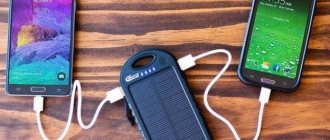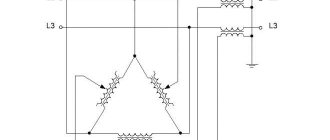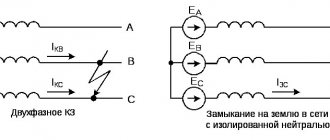Electronic gadgets have become an integral part of human life. Smartphones, tablets, laptops are devices for work and entertainment, but the unpleasant thing is that they run out of charge and turn off. Many people, in order to “extend the life” of their gadget, buy external batteries, better known as power banks. But the fact is that the “can” itself must be charged from the mains. Less often, but still. A way out of this situation could be a power bank with a solar battery. The technology is widespread, especially among those who spend more time away from outlets, because accumulating solar energy is simple and free. “Solar” power bank - what are its features and what is its operating principle - this is what we will talk about. Popular models of similar “cans” will also be presented.
A solar power bank works by converting solar radiation into electricity.
Myths and reality
One of the popular and discussed external energy storage devices today is solar power bank . This is a monoblock capable of receiving solar energy through built-in photocells, converting it into electrical energy and storing it in its own batteries. A very convenient and useful device, especially for lovers of long hikes or people working far from sources of electricity.
There are many articles on the Internet advertising such devices, like solar-powered power banks. Users' opinions about them are very contradictory; absolutely opposite points of view are expressed. However, no one argues about the benefits and convenience of such devices.
Manufacturers claim that it is enough to place the drive in an area of direct access to sunlight and wait until it is fully charged, which will happen in about a day. After this, a device with a capacity of 50,000 mah will be able to charge a mobile phone 25 times , so the stored energy will be enough. It looks very tempting, but how true this is is the question. Let's try to figure out which of these statements is true and which is a myth.
The first revelation is the weight of the device
Manufacturers claim that the weight of a 20,000 mah solar-powered power bank is 200 g. Let’s do the math ourselves. The weight of one 2000 mah lithium battery is about 30-40 g. This means that a capacity of 20,000 mah is obtained from a battery made up of 10 such batteries. It turns out that the weight of the batteries alone , without housing, solar panels and other electronic components, is 300-400 g .
Then the entire drive will weigh no less than half a kilogram, which in no way corresponds to the manufacturers’ statements. And this is not the most powerful device yet; a power bank with a 50,000 mah solar battery will pull more than a kilogram . There is some, to put it mildly, cunning on the part of the manufacturers, which only works to their detriment.
The second myth is that it can be charged from the sun in one day.
The solar power bank is equipped with a thin film photocell. A solar battery of this type with an area of 1 m2 produces 200 mah. The solar battery area of one device can provide no more than 8 mah. This means that a power bank a 20,000 mah solar battery .
Considering the fact that the sun does not shine for a full day even on the longest days of the year, the efficiency of solar panels is, at best, sufficient to power the charge indicators . It turns out that the device from solar panels will never be able to charge . In this case, doubt arises about the integrity of the manufacturers, who could not have been unaware of the inadequacy of solar panels of such area and power for charging high-capacity batteries.
What to look for when choosing
Below we will consider the most popular models of external solar power banks. When choosing a device, it is recommended to pay attention to the popularity of the brand - when you buy a product from a little-known manufacturer, there is a chance of running into poor quality assembly or inconsistency of characteristics. Also pay attention to the main parameters of the device:
- Capacitance and voltage. These characteristics are closely related to each other. The unit of capacity is mAh (milliampere * hour). When choosing a model, keep in mind that the rated voltage of the battery cells is usually lower than that of the gadget being charged. Thus, most of the energy will be spent on operating the boost circuit.
- Rated current – the duration of charging of connected gadgets depends on the value of this parameter. Universal models of external batteries are equipped with several USB ports with different charge currents. The choice of socket for connection depends on the type of device. To charge a smartphone, a current of 1-2 A will be enough, and a tablet - usually at least 2 A, but for laptops it is necessary that the device produces a voltage of 12-19 volts and a higher current (2.5 A and higher), or a laptop and power banks supported USB PD fast charging technology
You can read more about external batteries for laptops in another article: which power bank to choose for a laptop.
If the output current becomes too low, the charging speed will increase significantly.
- Contents of delivery . The presence of cables and adapters reduces the cost of purchasing them.
- Additional features. Manufacturers provide their products with new features that may be useful in certain situations. For example, protection from dust and moisture or a built-in flashlight will come in handy while hiking. Other accessories include wireless access points and USB hubs. Expanding the functionality of the device has only one serious drawback - additional equipment leads to an increase in the price of the product.
When choosing a suitable model, consider the advantages and disadvantages of portable batteries using such batteries. Advantages:
- Possibility of charging from the sun.
- Good protection against dust and moisture penetration for most models.
- The use of solar panels does not pollute the environment.
- Tourist models are made of high-strength plastic that is resistant to scratches, shocks and other mechanical impacts.
The list of shortcomings is longer:
- Since it must be in the sun while charging, the battery will overheat. And frequent overheating of devices negatively affects the performance and service life of battery cells.
- Very often they do not meet the stated characteristics.
- Large weight and dimensions compared to classic devices.
- Low efficiency of solar models.
- Unreasonably high price.
Why do they make this?
According to the manufacturers, a solar-powered power bank is perfect for all tourists , people working in the field and other users who are often located far from traditional chargers.
Since practice (and the simplest calculation) does not confirm the ability of solar panels of this type to charge storage batteries, we can safely say that a power bank with a solar panel is not capable of providing the declared functions and is a regular marketing ploy (one can put it more categorically).
A great idea is taken and implemented in such a way that the user pays money in hopes of receiving a fully functioning device. At the same time, such production cannot be called a fraud at all, since the drive is fully functional when charging from other sources . However, the main advantage - the use of solar energy - is not provided.
Aukey PB-P23
Characteristics
General characteristics
- Capacity : 16000 mAh
- Simultaneous charging of two devices : yes
- Solar battery : yes
- Fast charging support : yes, Qualcomm Quick Charge 3.0
Entrance
- Connector : micro USB or USB Type-C
Exit
- Connectors : USB, USB Type-C
- Adapter for micro USB : yes
Additionally
- Charge indicator : yes
- Dimensions : 75x160x23 mm
- Weight : 360 g
- Contents : USB cable - micro USB
Price
Price from 2,990 to 4,590 (Average price: 3,390 RUR)
11
Separate solar panel
There are portable solar panels that do not have built-in batteries. They are not capable of storing energy for future use and are designed for direct charging of mobile gadgets . Some models have quite a lot of power and are capable of charging car batteries, which is very useful for lovers of long trips. The voltage that portable solar batteries can produce is up to 12 or 24 V, which significantly exceeds the capabilities of conventional chargers for mobile phones or audio players.
A common feature of solar panels that do not have built-in batteries is fairly high power and high charging speed . One of the reasons for such high efficiency is the use of predominantly monocrystalline elements with maximum efficiency. In addition, the area of such devices when unfolded reaches a quarter of a square meter (or even more), which gives greater efficiency from photocells.
Externally, they are a flexible case in which solar panels are installed . When folded, the size of the device is close to the format of a regular book, but when unfolded, the area increases several times, which ensures high performance of the device. To obtain maximum effect, it is necessary to position the panels perpendicular to the solar flow.
Is it worth buying a Power bank?
You should not buy a power bank with a solar battery . This statement seems overly categorical, but practice shows that it is quite reasonable and fair. Such a purchase is not justified either economically or technically.
Objective reasons for refusing to use such devices are:
- Lack of solar cell power to load the built-in batteries.
- The service life of cheap batteries is extremely low, and if it is impossible to fully charge, it quickly decreases.
- The operating mode of the built-in batteries depends on the air temperature. When operating in cold weather, the ability to load/unload batteries drops sharply.
- Most power bank models with a solar battery cannot work simultaneously to charge gadgets and receive solar energy. You have to charge the batteries first, and only then charge your mobile devices. This almost completely defeats the whole point of using a solar power bank.
HARPER PB-0010
Characteristics
General characteristics
- Capacity : 10000 mAh
- Simultaneous charging of two devices : yes
- Flashlight : yes
- Solar battery : yes
Entrance
- Connector : micro USB
- Voltage : 5V
- Current : 2 A
Exit
- Maximum current : 2.1 A
- Connectors : USBx2
- Maximum current on USB 1 : 2.1 A
- Maximum current on USB 2 : 2.1 A
- Adapter for Apple 30 pin : yes
- Adapter for micro USB : yes
Battery
- Type : Li-Polymer
- Charging time : 6 h
- Number of charging cycles: 500
Additionally
- Overload protection : yes
- Charge indicator : yes
- Operating temperature : 0 - 45 °C
- Waterproof housing : yes
- Dimensions : 120x73x30 mm
- Weight : 300 g
Price
Price: 2,445 RUR
Reviews
pros
design, capacity, solar battery
Minuses
large and voluminous in size
A comment
I bought it mainly for hiking, to use with a portable speaker. Of course, it takes up a lot of space, but I am confident in its durability, since the connectors are protected from moisture and debris, as well as resistance to mechanical stress. The USB connectors are located vertically, making it convenient to charge several devices at once.
pros
Decent volume, enough to charge a smartphone 4 times. Comes with a protective rubber bumper. It has a carabiner, meaning it can be attached to a backpack. There is a solar battery on the back side, that is, purely theoretically, it can be charged through it as well
Minuses
You can charge from two USB ports at the same time, but only one charges faster, the second slower
A comment
I decided to buy this one because it is shockproof, protected from dust and moisture (purely theoretically, I haven’t tested it). Well, the presence of a solar battery will still allow you to charge it on a hike in a pinch.
pros
It came complete with a shockproof bumper with a carabiner. On the reverse side there is a solar battery from which, theoretically, it is also charged. The battery capacity is quite normal. 10,000 is enough to charge both a smartphone and a camera
Minuses
It weighs decently despite its size due to the metal body. The solar battery charges slowly
A comment
I bought it because my passion for hiking intensifies in the summer. Therefore, a portable battery becomes very important. And this model is very well suited for this task. That’s why I bought this one even though I came across cheaper ones with a larger volume
pros
capacity, moisture protection, 2 ports
Minuses
weight
A comment
I bought it as a gift for my friend, the original design, not like everyone else, that’s why I was interested in it. USB inputs are located vertically, which makes it possible to simultaneously charge several devices. I tested the charger on my phone, it charges completely in about 1 hour.
Minuses
Big enough
A comment
The battery capacity is quite decent – 10,000 mAh. It takes you to charge your mobile phone four times. It charges completely overnight – from the last bar on the indicator to full scale. So far it functions as stated by the manufacturer. Duration of use – 4 months
A comment
The solar battery is not very useful, mainly to compensate for the work of the flashlight.
pros
Compact and lightweight. into the protective bumper. Fully charges the phone/player, provided that it itself is fully charged. For some, a flashlight might be an advantage.
Minuses
I don’t really understand the presence of a solar panel. In reality, it charges 20% per day. By the way, it charges quite quickly from the network. Completely in 8 hours.
A comment
In principle, the model is good. The price suited me. I haven't seen any serious flaws in it yet. Special thanks to the manufacturers for including a large number of adapters for all common connectors in the kit.
Minuses
flashlight











